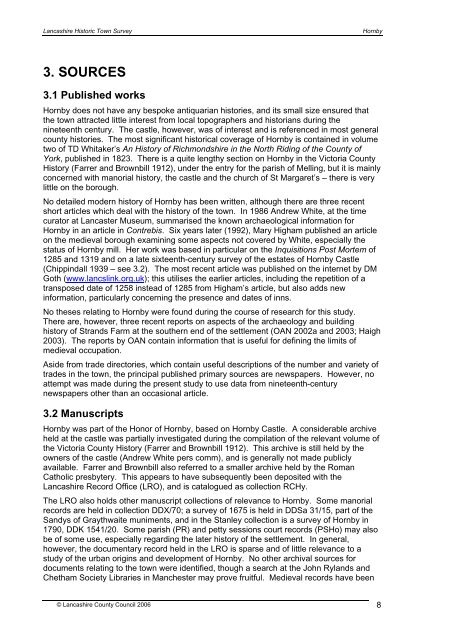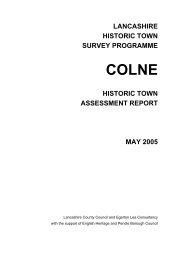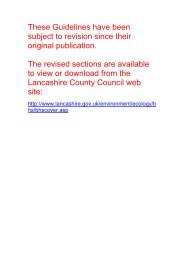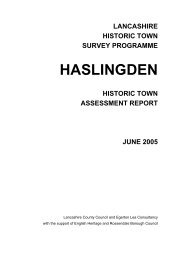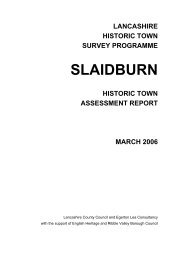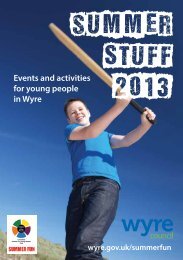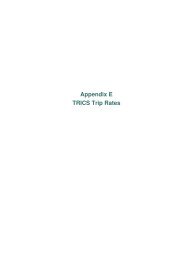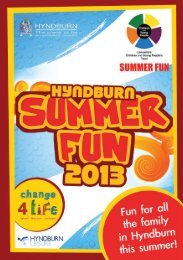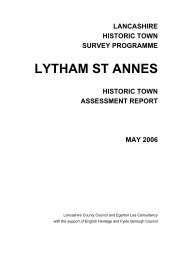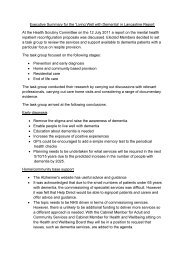HORNBY - Lancashire County Council
HORNBY - Lancashire County Council
HORNBY - Lancashire County Council
Create successful ePaper yourself
Turn your PDF publications into a flip-book with our unique Google optimized e-Paper software.
<strong>Lancashire</strong> Historic Town SurveyHornby3. SOURCES3.1 Published worksHornby does not have any bespoke antiquarian histories, and its small size ensured thatthe town attracted little interest from local topographers and historians during thenineteenth century. The castle, however, was of interest and is referenced in most generalcounty histories. The most significant historical coverage of Hornby is contained in volumetwo of TD Whitaker’s An History of Richmondshire in the North Riding of the <strong>County</strong> ofYork, published in 1823. There is a quite lengthy section on Hornby in the Victoria <strong>County</strong>History (Farrer and Brownbill 1912), under the entry for the parish of Melling, but it is mainlyconcerned with manorial history, the castle and the church of St Margaret’s – there is verylittle on the borough.No detailed modern history of Hornby has been written, although there are three recentshort articles which deal with the history of the town. In 1986 Andrew White, at the timecurator at Lancaster Museum, summarised the known archaeological information forHornby in an article in Contrebis. Six years later (1992), Mary Higham published an articleon the medieval borough examining some aspects not covered by White, especially thestatus of Hornby mill. Her work was based in particular on the Inquisitions Post Mortem of1285 and 1319 and on a late sixteenth-century survey of the estates of Hornby Castle(Chippindall 1939 – see 3.2). The most recent article was published on the internet by DMGoth (www.lancslink.org.uk); this utilises the earlier articles, including the repetition of atransposed date of 1258 instead of 1285 from Higham’s article, but also adds newinformation, particularly concerning the presence and dates of inns.No theses relating to Hornby were found during the course of research for this study.There are, however, three recent reports on aspects of the archaeology and buildinghistory of Strands Farm at the southern end of the settlement (OAN 2002a and 2003; Haigh2003). The reports by OAN contain information that is useful for defining the limits ofmedieval occupation.Aside from trade directories, which contain useful descriptions of the number and variety oftrades in the town, the principal published primary sources are newspapers. However, noattempt was made during the present study to use data from nineteenth-centurynewspapers other than an occasional article.3.2 ManuscriptsHornby was part of the Honor of Hornby, based on Hornby Castle. A considerable archiveheld at the castle was partially investigated during the compilation of the relevant volume ofthe Victoria <strong>County</strong> History (Farrer and Brownbill 1912). This archive is still held by theowners of the castle (Andrew White pers comm), and is generally not made publiclyavailable. Farrer and Brownbill also referred to a smaller archive held by the RomanCatholic presbytery. This appears to have subsequently been deposited with the<strong>Lancashire</strong> Record Office (LRO), and is catalogued as collection RCHy.The LRO also holds other manuscript collections of relevance to Hornby. Some manorialrecords are held in collection DDX/70; a survey of 1675 is held in DDSa 31/15, part of theSandys of Graythwaite muniments, and in the Stanley collection is a survey of Hornby in1790, DDK 1541/20. Some parish (PR) and petty sessions court records (PSHo) may alsobe of some use, especially regarding the later history of the settlement. In general,however, the documentary record held in the LRO is sparse and of little relevance to astudy of the urban origins and development of Hornby. No other archival sources fordocuments relating to the town were identified, though a search at the John Rylands andChetham Society Libraries in Manchester may prove fruitful. Medieval records have been© <strong>Lancashire</strong> <strong>County</strong> <strong>Council</strong> 2006 8


